1 . Most parents can remember the artful mix of excitement and anxiety accompanying the choice of their baby’s name—it will follow the child his or her entire life. But the effect could be even more significant. In research recently published in the Journal of Personality and Social Psychology, our research team shows that the stereotype (模式思维) that a given society has of a first name can influence the way people look.
In eight studies, we found that participants shown ID-style photos of people they’d never met were able to recognize the first name of the described person well above the chance level. In other words, there is something about an Emily that…just looks like an Emily.
If an Emily really does look like an Emily, even a computer should be able to guess her true name. The computer was even able to produce a “heat map” for each name, a face with the features that “betray” a person carrying that name shown in red or orange colors. How should we understand this effect? Until now, social psychologists knew that our facial appearance influences the extent to which others perceive us as attractive, intelligent, trustworthy or warm. These studies show that others’ perceptions of our first name are reflected in our faces.
Interestingly, the face -name effect occurs even if we can only see the hair of a person. Our hair is possibly the part of our face that we control with the most ease. The fact that this alone can produce the face name effect further illustrates the suspected self-fulfilling mechanism behind it.
Together, the eight studies suggest that we wear our social belonging on our face, and that we actively shape our features to be recognized by our reference group. Choosing baby names remains exciting. Whatever the first name you give to your child, he or she will end up wearing it.
1. What was the participants’ assignment?| A.To pick out ID-style photos they’d never met. |
| B.To match strangers’ photos with their names. |
| C.To find out Emily from various ID photos. |
| D.To perceive Emily’s character. |
| A.By drawing a map for each name. |
| B.By sorting out different faces in a map. |
| C.By showing a person’s face in different colors. |
| D.By highlighting certain features in warm colors. |
| A.People wear their character on their faces. |
| B.Hairstyle accounts for a large part in appearance. |
| C.A fixed idea of first names determines one’s look. |
| D.Social belonging is irrelevant to our facial features. |
P=Paragraph
A. | B. |
C. | D. |
2 . While we know that language first appeared among Homo sapiens (智人) somewhere thousands of years ago, the secret to how language evolved is still unknown, and mainstream theories fall into two distinctly different camps.
One widely held theory is that language came about as an evolutionary adaptation. That was where the idea of natural selection came into play, which was the belief that the specific physical features of a population made that population more likely to survive its environment, like the turtle (海龟) and its shell. On one hand, humans needed to communicate with each other in order to hunt,farm and defend themselves successfully from the surrounding severe environment. Being able to communicate by using language gave the human species a distinct survival advantage. On the other hand, language was needed for social interaction, according to those who subscribed to the adaptation theory.
In their paper “Natural Language and Natural Selection,” researchers Steven Pinker and Paul Bloom theorized that a series of calls or gestures evolved over time into combinations, giving us complex communication, or language. As things became more complicated around them,humans needed a more complex system to convey information to one another. Early man saw a group of deer he wanted to hunt. He made a sound to his hunting partner that means “deer are nearby.” One day,a storm came in and the hunter noticed that thunder scared the deer away. As a result, the hunter went hungry until the storm passed. Over time, the same hunter also learned to recognize the warning signs for bad weather-dark skies and increased wind. Early man realized that when the sky darkened and the wind picked up, he needed to tell his hunting partner to speed up the pursuit of the deer. Therefore, he came up with a series of sounds that refer to both the deer and the bad weather. That series of sounds was the beginning of an evolutionary adaptation that eventually became language.
As humans learned more about how to best survive, they developed a need to convey these survival methods to their population. To be brief, that's the adaptation theory.
1. What is the text mainly about?| A.The evolution of language. |
| B.The paper on natural selection. |
| C.The differences between theories. |
| D.The introduction to human reproduction. |
| A.To show the mystery of nature. |
| B.To support the evolutionary adaptation. |
| C.To stress the advantage of the turtle's shell. |
| D.To encourage people to study natural selection. |
| A.By comparing. | B.By listing data. |
| C.By carrying out a survey. | D.By giving an example. |
| A.The exact place where humans came from. |
| B.The other theory of how language evolved. |
| C.The reasons why animals cannot form language. |
| D.The methods of humans' shaping non- verbal thinking. |
3 . The British people have just discovered a new country. It’s called the UK! More and more people are choosing to take their holidays in their own country rather than travel abroad.
In the late 1970s, air travel became affordable for the average family in the UK, and more and more British people started travelling abroad for their summer holidays (July-August). After all, the British weather isn’t very good, even in summer, so a lot of Britons leave the UK for a vacation. Particularly popular with families on a budget is the “package holiday”, where the cost of flights and accommodation are offered as one discounted price by travel agents.
In the 1980s and 1990s, young people in the UK became more wealthy. As a result, the Club 18-30 holiday became popular. Young people started to go abroad in groups, to places such as Spain and Greece. Once at their destination, they socialised with other groups of young people and had one long party.
British holidaying habits have begun to change, however. Climate change means that the UK now has a warmer climate than before, so people don’t always feel they need to go overseas to find good weather. Also, the world seems a less certain place as interconnected economies rise and fall, which means that the cost of foreign holidays is less predictable than it used to be. As a result, more and more Britons are choosing to spend their summer holidays in the UK.
In recent years, British hotels in areas such as the English Lake District have seen a large increase in bookings. That rise is mainly owing to the British staying in their own country for their holidays. In addition, for some foreign tourists, the UK is a cheaper place to visit than previously because of changes in the value of the British pound.
The UK has always been famous for its international explorers, but now it is starting to discover itself.
1. What is the feature of the Club 18-30 holiday?| A.Young people went abroad with their family. |
| B.Young people got lots of money from their family. |
| C.Young people took part in social activities abroad. |
| D.Travel agents offered a better discount to young people. |
| A.They are wealthier and more social. |
| B.The global weather is becoming predictable. |
| C.The UK is famous for its beautiful scenery. |
| D.The expense on foreign holidays is unsteady. |
| A.In order of frequency. | B.In order of time. |
| C.In order of space. | D.In order of importance. |
| A.Holidays and Habits | B.Weather and Scenery |
| C.Travels and Economies | D.Package Holiday and Culture |
4 . Tired of your ordinary earthly vacations? Some day soon you might be able to board a rocket and get a room with a view of the whole planet — from a hotel in space.
At least, that is the sales pitch(高调) of several companies racing to become the first to host guests in orbit on purpose-built space stations.
“It sounds kind of crazy to us today because it is not a reality yet,” said Frank Bunger, founder of U.S. aerospace firm Orion Span, one of the companies vying to take travellers out of this world. “But that’s the nature of these things, it sounds crazy until it is normal.”
U.S. multimillionaire Dennis Tito became the world's first paying space tourist in 2001, travelling to the International Space Station (ISS) aboard a Russian Soyuz rocket for a reported $20 million. A few others have followed. Since then, companies like Boeing, SpaceX and Blue Origin have been working on ways to bring the stars into reach for more people — opening up a new business frontier for would-be space hoteliers.
U.S. space agency NASA announced in June that it plans to allow two private citizens a year to stay at the ISS at a cost of about $35,000 per night for up to a month. The first mission could be as early as 2020.
But the growing movement has raised questions about the adequacy of current space laws, which mainly deal with exploration and keeping space free of weapons, not hotels and holidaymakers.
“It is difficult now to want to do things in space and get a clear answer from space law,” said Christopher Johnson, a space law adviser at the Secure World Foundation, a space advocacy group. “For something as advanced as hotels in space there is no clear guidance.”
1. What does the underlined word “vying” in Para. 3 mean?| A.Promising. | B.Competing. |
| C.Hesitating. | D.Risking. |
| A.To show he was wealthy enough. |
| B.To praise his contribution. |
| C.To tell us he was very brave. |
| D.To emphasize he took the lead. |
| A.By summary. | B.By comparison. |
| C.By listing figures. | D.By giving examples. |
| A.He opposes space travel. |
| B.He is in charge of a space law. |
| C.It’s urgent to make a space law. |
| D.Space hotels are badly needed. |
5 . The tall manchineel tree that is native to the Caribbean, Florida, South America, Central America and the Bahamas, looks particularly attractive. But you may be wise to notice the warning given that the tree holds the Guinness World Record for “the world’s most dangerous tree”.
The deadliness begins with the sweet-smelling fruit. As British radiologist Nicola Strickland and her friend discovered, even a single bite of the green apple-like produce can lead to hours of suffering. The scientist says within minutes of eating the fruit, she and her friend experienced “a strange peppery feeling” in their mouths. A few hours later, the two could barely swallow any solid food. Fortunately, the symptoms started to reduce after about eight hours and the fruit did not cause any long-term damage.
Many plants have poisonous bark and leaves to prevent grass-eating animals. However, the fruits are usually edible allowing animals to feed on them or carry seeds to help with reproduction. But since the manchineel fruits are largely transported by ocean tides, the tree does not need help to reproduce.
The tree’s thick and milky white sap (树液) is equally dangerous. Contact with the skin can lead to symptoms that range from headaches to respiratory(呼吸) problems. Exposure to the eye can even cause “temporary painful blindness”. Given that the sap’s most dangerous toxin is highly water soluble, experts advise not using the tree for shade during a rain shower, as raindrops carrying the sap could easily burn your skin.
The fear has resulted in almost destroying the tree in Florida where it is on the list of endangered species. While removing it altogether may seem like the logical solution, experts argue that the manchineel trees are important for local ecosystems. In addition to protecting against ocean winds, the dense manchineel trees also prevent ocean erosion in Central America. The tree’s wood is very popular with Caribbean carpenters who have learned to neutralize its poisonous sap by drying the bark in the sun. In Central and South America, the locals use the bark to treat body swelling caused by injury and infection.
1. Which of the following best explains “edible” underlined in Paragraph 3?| A.Fit to eat. | B.Easy to pick. | C.Hard to find. | D.Nice to look at. |
| A.Its fruits taste sweet. |
| B.It reproduces by ocean tides. |
| C.Your eyes may be blind at the sight of it. |
| D.You have difficulty breathing in its shade. |
| A.The medical use of the manchineel trees. |
| B.The important role of the manchineel trees. |
| C.The urgent need of protecting the manchineel trees. |
| D.The way of removing poisonous sap from the trees. |
A. | B. | C. | D. |
6 . High school biology teacher Kelly Chavis knew smartphones were a problem in her class. But not even the students realized how much of a problem the devices were until Chavis did an in-class experiment.
For one class period, students used a whiteboard to count every Snapchat, Instagram, text, call that appeared on their phones. Chavis is among a growing number of teachers, parents and health experts who believe that smartphones are now partly to blame for increasing the levels of student anxiety. “One girl, just during the one hour, got close to 150 Snapchat notifications. 150!” she said.
Jean Twenge, a psychology professor at San Diego State University in California, said it is not a coincidence that youth mental health issues have risen with the number of phones. “This use of phones has led to a loss of sleep and face-to-face interactions necessary for their growth,” she said.
Researchers are still not sure whether phones cause student depression or depression causes phone use. But nearly 60 percent of parents said they worry about the influence of social media on their child’s physical and mental health.
Both schools and parents are starting to take steps to deal with the problem. Many public schools pay outside companies to watch students’ social media activity for signs of anxiety. Other schools invite in yoga teachers and comfort dogs to help calm students.
1. What’s the purpose of Chavis’s experiment?| A.To see how many students have smartphones. |
| B.To find out how popular her students are. |
| C.To show smartphones influence teenagers greatly. |
| D.To tell her students how to use smartphones wisely. |
| A.Shocked. | B.Excited. | C.Satisfied. | D.Frightened. |
| A.Students are now under great stress. |
| B.Students spend too much money on smartphones. |
| C.Over-using phones cause drops in students’ grades. |
| D.Over-using phones may harm students’ body and mind. |
| A.How other schools deal with students’ phones. |
| B.Whether the ways to handle phones are effective. |
| C.How some parents deal with their children’s phones. |
| D.Whether students are willing to give up using phones. |
The production of coffee beans is a huge, profitable business, but, unfortunately, full-sun production is taking over the industry and bringing about a lot of damage. The change in how coffee is grown from shade-grown production to full-sun production endangers the very existence of, certain animals and birds, and even disturbs the world’s ecological balance.
On a local level, the damage of the forest required by full-sun fields affects the area’s birds and animals. The shade of the forest trees provides a home for birds and other special(物种) that depend on the trees’ flowers and fruits. Full-sun coffee growers destroy this forest home. As a result, many special are quickly dying out.
On a more global level, the destruction of the rainforest for full-sun coffee fields also threatens(威胁)human life. Medical research often makes use of the forests' plant and animal life, and the destruction of such species could prevent researchers from finding cures for certain diseases. In addition, new coffee-growing techniques are poisoning the water locally, and eventually the world's groundwater.
Both locally and globally, the continued spread of full-sun coffee plantations (种植园)could mean the destruction of the rainforest ecology. The loss of shade trees is already causing a slight change in the world's climate, and studies show that loss of oxygen-giving trees also leads to air pollution and global warming. Moreover, the new growing techniques are contributing to acidic(酸性的) soil conditions.
It is obvious that the way much coffee is grown affects many aspects many aspects of life, from the local environment to the global ecology. But consumers do have a choice. They can purchase shade-grown coffee whenever possible, although at a higher cost. The future health of the planet and mankind is surely worth more than an inexpensive cup of coffee.
1. What can we learn about full-sun coffee production from Paragraph 4?
| A.It limits the spread of new growing techniques. |
| B.It leads to air pollution and global warming. |
| C.It slows down the loss of shade trees. |
| D.It improves local soil conditions. |
| A.entertain | B.advertise | C.instruct | D.persuade |
| A.An agricultural magazine. |
| B.A medical journal. |
| C.An engineering textbook. |
| D.A tourist guide. |
A. | B. |
C.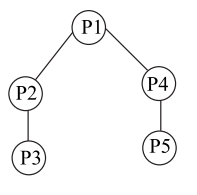 | D.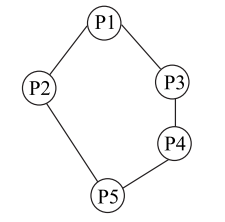 |
8 . As Internet users become more dependent on the Internet to store information, are people remember less? If you know your computer will save information, why store it in your own personal memory, your brain? Experts are wondering if the Internet is changing what we remember and how.
In a recent study, Professor Betsy Sparrow conducted some experiments. She and her research team wanted to know the Internet is changing memory. In the first experiment, they gave people 40 unimportant facts to type into a computer. The first group of people understood that the computer would save the information. The second group understood that the computer would not save it. Later, the second group remembered the information better. People in the first group knew they could find the information again, so they did not try to remember it.
In another experiment, the researchers gave people facts to remember, and told them where to find the information on the Internet. The information was in a specific computer folder (文件夹). Surprisingly, people later remember the folder location (位置) better than the facts. When people use the Internet, they do not remember the information. Rather, they remember how to find it. This is called “transactive memory (交互记忆)”
According to Sparrow, we are not becoming people with poor memories as a result of the Internet. Instead, computer users are developing stronger transactive memories; that is, people are learning how to organize huge quantities of information so that they are able to access it at a later date. This doesn’t mean we are becoming either more or less intelligent, but there is no doubt that the way we use memory is changing.
1. The passage begins with two questions to ________.| A.introduce the main topic | B.show the author’s attitude |
| C.describe how to use the Internet | D.explain how to store information |
| A.Sparrow’s team typed the information into a computer. |
| B.The two groups remembered the information equally well. |
| C.The first group did not try to remember the formation. |
| D.The second group did not understand the information. |
| A.keep the information in mind |
| B.change the quantity of information |
| C.organize information like a computer |
| D.remember how to find the information |
| A.We are using memory differently. |
| B.We are becoming more intelligent. |
| C.We have poorer memories than before. |
| D.We need a better way to access information. |
“In wilderness(荒野) is the preservation of the world.” This is a famous saying from a writer regarded as one of the fathers of environmentalism. The frequency with which it is borrowed mirrors a heated debate on environmental protection: whether to place wilderness at the heart of what is to be preserved.
As John Sauven of Greenpeace UK points out, there is a strong appeal in images of the wild, the untouched; more than anything else, they speak of the nature that many people value most dearly. The urge to leave the subject of such images untouched is strong, and the danger exploitation(开发) brings to such landscapes(景观) is real. Some of these wildernesses also perform functions that humans need—the rainforests, for example, store carbon in vast quantities. To Mr.Sauven, these ”ecosystem services” far outweigh the gains from exploitation.
Lee Lane, a visiting fellow at the Hudson Institute, takes the opposing view. He acknowledges that wildernesses do provide useful services, such as water conservation. But that is not, he argues, a reason to avoid all human presence, or indeed commercial and industrial exploitation. There are ever more people on the Earth, and they reasonably and rightfully want to have better lives, rather than merely struggle for survival. While the ways of using resources have improved, there is still a growing need for raw materials, and some wildernesses contain them in abundance. If they can be tapped without reducing the services those wildernesses provide, the argument goes, there is no further reason not to do so. Being untouched is not, in itself, a characteristic worth valuing above all others.
I look forwards to seeing these views taken further, and to their being challenged by the other participants. One challenge that suggests itself to me is that both cases need to take on the question of spiritual value a little more directly. And there is a practical question as to whether wildernesses can be exploited without harm.
This is a topic that calls for not only free expression of feelings, but also the guidance of reason. What position wilderness should enjoy in the preservation of the world obviously deserves much more serious thinking.
1. John Sauven holds that_____.
| A.many people value nature too much |
| B.exploitation of wildernesses is harmful |
| C.wildernesses provide humans with necessities |
| D.the urge to develop the ecosystem services is strong |
| A.The exploitation is necessary for the poor people. |
| B.Wildernesses cannot guarantee better use of raw materials. |
| C.Useful services of wildernesses are not the reason for no exploitation. |
| D.All the characteristics concerning the exploitation should be treated equally. |
| A.Objective. | B.Disapproving. | C.Sceptical. | D.Optimistic. |
CP: Central Point P: Point Sp: Sub-point(次要点) : Conclusion
A.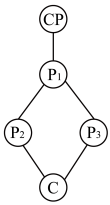 | B.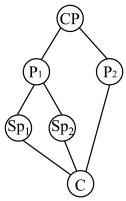 | C. | D.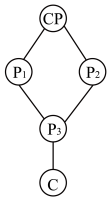 |



